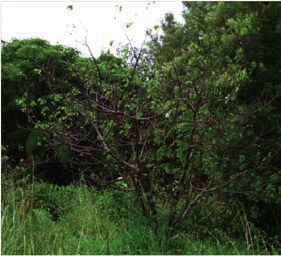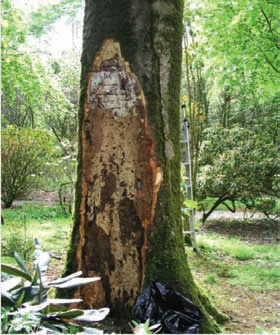PESTS AND DISEASES OF FORESTRY IN NEW ZEALAND
Phytophthora kernoviae: Past investigation throws up new answers
From Biosecurity issue 82, March 2008.
A classic piece of scientific detective work and collaboration has thrown new light on a woodland pathogen only recently confirmed in New Zealand. Revisiting an investigation from the 1960s has revealed that Phytophthora kernoviae (Pk) has been in this country longer than first thought.

In 2005, scientists from Landcare Research, Ensis (now Scion) and HortResearch examined New Zealand's laboratory collections of Phytophthora and discovered the presence of Phytophthora kernoviae (Pk), a recently described species associated with significant disease in several plant species in the United Kingdom.
The New Zealand specimen had been isolated from cherimoya material submitted by a grower in 2002. MAF initially identified this material as another Phytophthora species known to be present in New Zealand. The use of molecular diagnostic techniques by the scientific team, however, revealed that Pk was present on cherimoya.
MAF Biosecurity New Zealand (MAFBNZ) immediately commenced surveillance and tracing work to determine where this disease came from and how far it had spread. In the meantime, the scientists examined further isolates collected from soil in kauri forests in Northland and identified Pk in a single sample. Tests of kauri that were showing signs of die-back in Northland, Waitakere Ranges and Great Barrier all tested negative for the presence of Pk, and other causes of the dieback in kauri are being investigated.
Apart from the cherimoya plants in Northland, no symptoms have been observed in the field that can be attributed to Pk. This was in contrast to the situation in the United Kingdom, where Pk was associated with significant disease symptoms on a number of species.

Shortly after MAFBNZ convened a Technical Advisory Group meeting, a 1970 thesis came to light describing a Phytophthora collected from soil under pine plantations in the central North Island. The description in the thesis was sufficiently similar to the published description of Pk to warrant MAFBNZ investigators and scientists taking a closer look. They collected material from the sites sampled in the 1960s and re-isolated the organism. Subsequent analysis of the material they collected revealed that Pk was present at many of those sites, and that the Phytophthora described in 1970 was indeed Pk.
The distribution of Pk in the Northland, Auckland, Taupo and Waikato regions, as well as the length of time it has been present in New Zealand, meant that neither eradication nor containment were feasible options.
This case was an example of MAFBNZ working in close partnership with the New Zealand scientific community and their overseas colleagues to investigate and clarify a complex situation. The linkage of historical New Zealand Phytophthora records to a modern incursion scenario has shown the importance of maintaining links with work carried out in the past, and to constantly re-examine old information in the light of new techniques.
George Gill, Senior Adviser Plant Response, Post Border Directorate, george.gill@maf.govt.nz
www.defra.gov.uk/planth/pestnote/kern.pdf

 Farm Forestry New Zealand
Farm Forestry New Zealand

